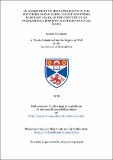Files in this item
An assessment of MODIS products in the Southern Ocean using tagged southern elephant seals, in the context of an increasingly positive Southern Annular Mode
Item metadata
| dc.contributor.advisor | Boehme, Lars | |
| dc.contributor.author | Biermann, Lauren | |
| dc.coverage.spatial | li, 245 p. | en_US |
| dc.date.accessioned | 2018-07-20T13:07:33Z | |
| dc.date.available | 2018-07-20T13:07:33Z | |
| dc.date.issued | 2018 | |
| dc.identifier.uri | https://hdl.handle.net/10023/15613 | |
| dc.description.abstract | The Southern Ocean maintains a complex, dynamic marine food web based on its stock of photosynthesising phytoplankton. For the same reason, it is our most significant sink of carbon, vital to functioning of global atmospheric systems. However, this key polar ocean is also responsive to atmospheric variability dominated by the Southern Annular Mode (SAM), with unknown implications for phytoplankton patterns in space and over time. MODIS surface chlorophyll-a concentration ([Chl-a]) and the depth of the 1% light level (Z[sub]eu) were evaluated against in situ fluorescence and light data collected by tagged southern elephant seals. Light data were processed to minimize self-shading and environmental sources of variability, and Lee Z[sub]eu outperformed Morel Z[sub]eu when examined relative to the resultant in situ measures of the 1% light level. Based on these results, fluorescence data were corrected for quenching at the surface using Lee Z[sub]eu as a reference depth; conserving deep chlorophyll maxima within hydrographically defined mixed layers. [Chl-a] was evaluated against quenching-corrected fluorescence and satellite products mirrored in situ trends over time. The MODIS timeseries was interrogated for spatio-temporal shifts to phytoplankton abundance in surface waters. Trends over 13 years of austral summers point to overall declines and perturbations to the timing of the bloom, with changes that were significantly related to the SAM presenting as regional rather than annular. In this context, to assess if perturbations may impact top predators, the at-sea behaviour of tagged seals were examined relative to the fluorescence and light data they collected. Using a cumulative sums analysis of speed, foraging phases were distinguishable from ’outbound’ and ’homebound’ travel. When all phases were examined relative to fluorescence and the 1% light level, foraging appeared to be associated with increased phytoplankton abundance. This suggests that the future of these marine predators may be linked to shifting phytoplankton patterns. | en_US |
| dc.language.iso | en | en_US |
| dc.publisher | University of St Andrews | |
| dc.subject.lcc | QL737.P64B5 | |
| dc.subject.lcsh | Southern elephant seal--Antarctic Ocean--Monitoring | en |
| dc.subject.lcsh | Southern elephant seal--Antarctic Ocean--Behavior | en |
| dc.subject.lcsh | MODIS (Spectroradiometer)--Testing | en |
| dc.subject.lcsh | Marine phytoplankton--Case studies | en |
| dc.title | An assessment of MODIS products in the Southern Ocean using tagged southern elephant seals, in the context of an increasingly positive Southern Annular Mode | en_US |
| dc.type | Thesis | en_US |
| dc.contributor.sponsor | Marine Alliance for Science and Technology for Scotland (MASTS) | en_US |
| dc.type.qualificationlevel | Doctoral | en_US |
| dc.type.qualificationname | PhD Doctor of Philosophy | en_US |
| dc.publisher.institution | The University of St Andrews | en_US |
This item appears in the following Collection(s)
Items in the St Andrews Research Repository are protected by copyright, with all rights reserved, unless otherwise indicated.

